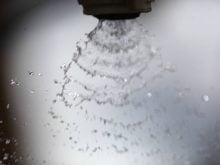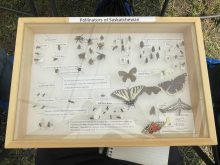Manitoba honey producers have launched an awareness campaign to protect their bees from friendly fire coming off sunflower fields.
The Manitoba Beekeepers Association is asking sunflower growers to use only certain insecticides when spraying for insect pests so as to avoid harming foraging honeybees.
A resolution adopted by the MBA at its annual meeting last fall calls for growers “to use only contact non-residual insecticides in sunflower fields.”
The problem with insecticides is that they can kill foraging bees as well as insect pests when applied directly. There are some bee-friendly products but none currently registered for use on sunflowers.
Read Also

Farmer-friendly nematodes: Tiny worms for big canola pest control
Not all nematodes are equal in farm fields. Beneficial species of the tiny soil-dwelling worms could one day help beat back damaging canola insect pests like diamondback moth on the Canadian Prairies.
Marc Nichol, who operates 1,800 honeybee colonies near MacGregor, said bee kills resulting from insecticides used on sunflower crops is a growing problem.
“There’s a huge concern about what they’re using on those sunflowers,” he said. “There’s no doubt they’re taking some of our bees out.”
Nichol, who has experienced bee kills in the past, said he now tries to avoid placing colonies near sunflower fields for fear of spray drift.
Confectionery sunflowers are sometimes sprayed more extensively than oilseed sunflowers because buyers want to avoid insect -damaged seeds used for human consumption. Beekeepers allege some sunflower seed packers require their growers to apply insecticides even when pests are below economic threshold levels.
John Gavloski, a Manitoba Agriculture, Food and Rural Initiatives entomologist, said only one insecticide does not kill bees on direct contact. That’s Dipel, a biological insecticide used to control the lepidoptera caterpillar.
“Otherwise, if you hit a bee, you’ll kill it,” Gavloski said.
He also said there are no non-residual insecticides, although some break down faster than others.
Manitoba produces relatively small volumes of sunflower honey. Most honey comes from canola, alfalfa and clover crops.
But sunflower honey can fetch a premium because of its dark-amber colour and pleasant aroma. Nichol said he got a British Columbia packer to extract 5,000 pounds of sunflower honey for him last summer. The return was $1.50 a pound, about 30 cents above the going rate for other honey.
Gavloski said bee kills can occur accidentally when any insecticide is used on a crop. Bees can be particularly at risk when canola is sprayed, since the majority of Manitoba honey comes from canola.
But the last major insect outbreak in canola occurred in the mid-1990s when the Bertha army worm caused extensive damage, insecticides were widely used and massive bee kills occurred. Since then, insect infestations in canola have been relatively low, Gavloski said.
David Ostermann, a provincial apiarist, said MAFRI recommends five procedures for pesticide applicators to follow in order to minimize damage to foraging bees.
They are: don’t spray crops in bloom, don’t spray when windy, spray in late evening or early morning when bees are less active, choose insecticides less toxic to bees, communicate with beekeepers about spraying plans.
Jill Lane, executive director of the Canadian Aerial Applicators Association in Edmonton, said provincial applicator groups try to work with honey producers to avoid bee kills.
Applicators must fill out worksheets detailing obstacles near fields to be sprayed, including honey hives, Lane said.
In Alberta, bee kills from insecticide are not an issue because applicators work in harmony with the Alberta Beekeepers Association, she said. [email protected]











![“It can sit dormant [on] equipment for years and years until hive stressors and hive conditions are right for it to infect the colony.” – Osee Podolsky, Canadian Honey Council.](https://static.manitobacooperator.ca/wp-content/uploads/2023/10/26104651/grafvision_GettyImages-178850019_cmyk-235x157.jpg)






